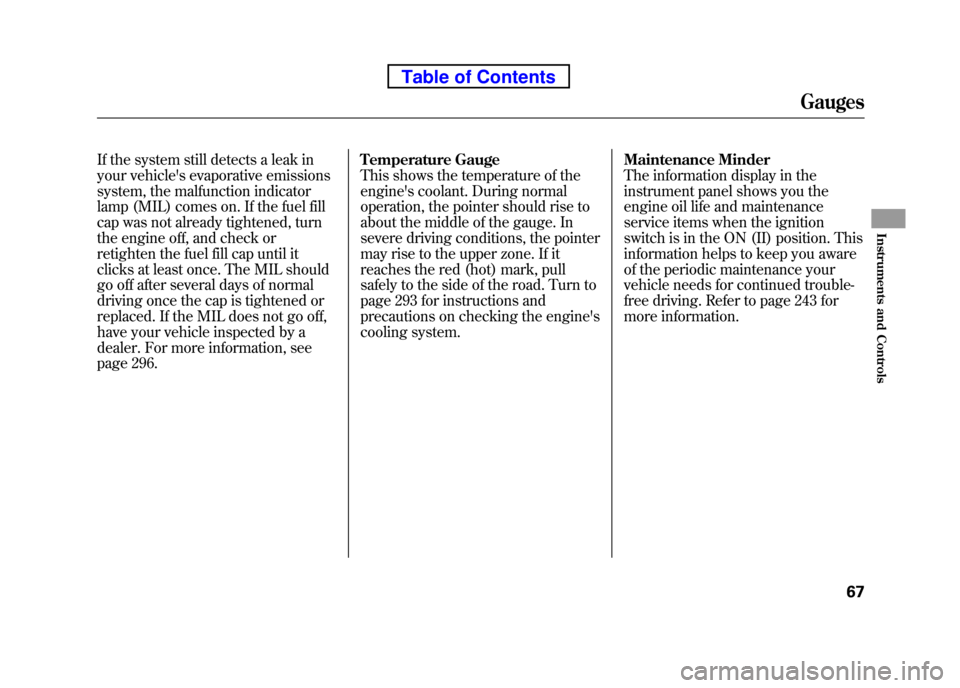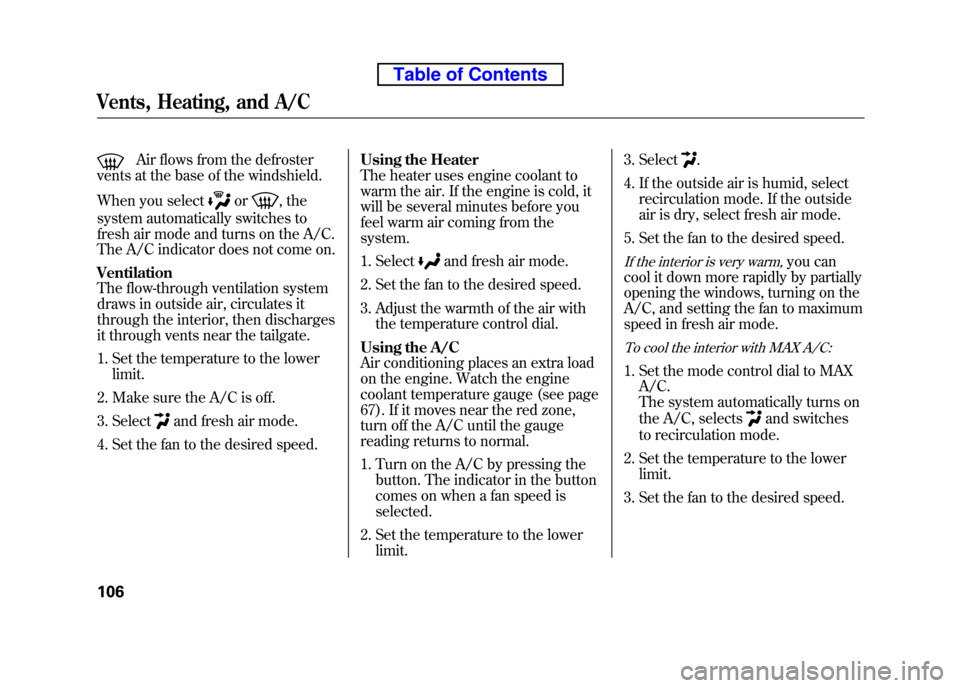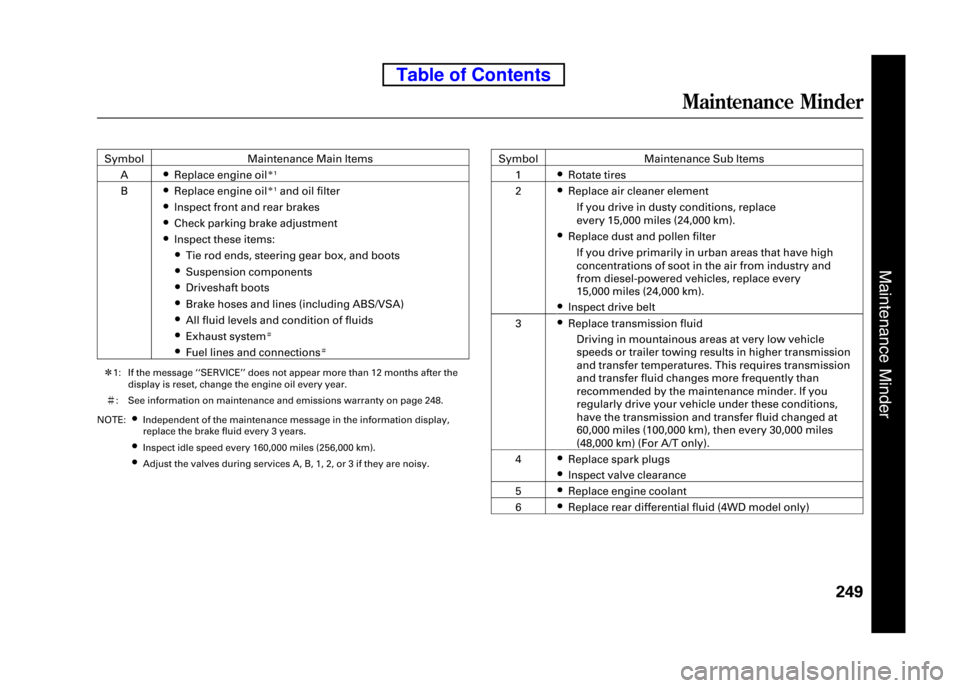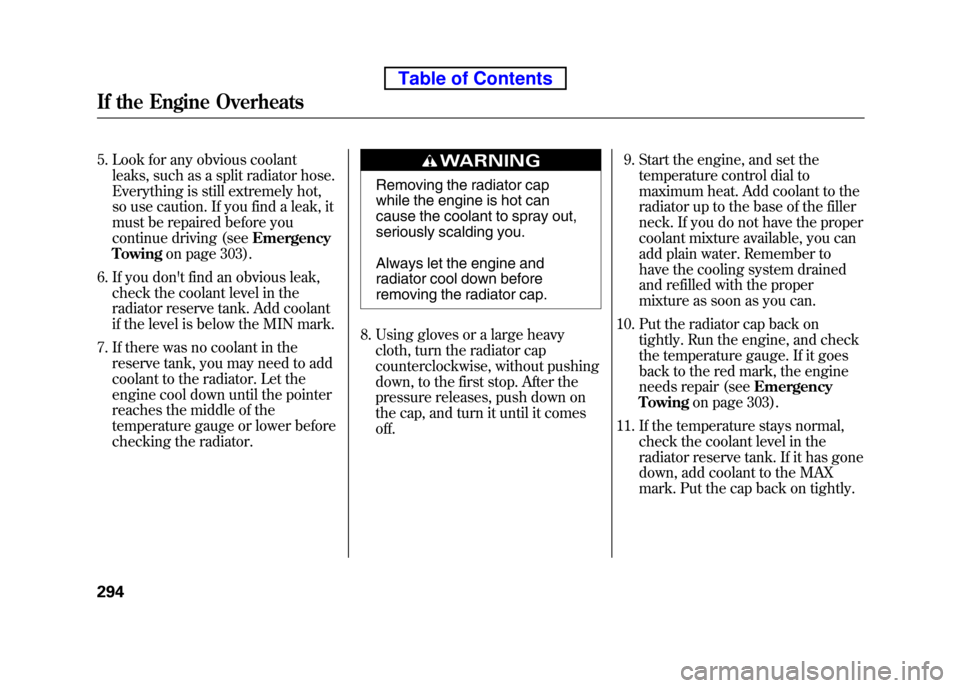coolant temperature HONDA ELEMENT 2010 1.G Owners Manual
[x] Cancel search | Manufacturer: HONDA, Model Year: 2010, Model line: ELEMENT, Model: HONDA ELEMENT 2010 1.GPages: 342, PDF Size: 5.76 MB
Page 2 of 342

Bulb ReplacementBack-up Lights ........................266
Brake Lights ........................... 266
Daytime Running Lights .........262
Front Parking/Turn Signal Lights .................................. 263
Front Side Marker Lights ........265
Headlights .............................. 261
High-mount Brake Light .........267
Rear Bulbs .............................. 266
Rear License Plate Lights ........267
Side Turn Signal Lights ...........264
Specifications .......................... 310
Taillights ................................. 266
Turn Signal Lights ..................266
Bulbs, Halogen .......................... 261
Bungee Cords ............................ 211
C
Capacities Chart .........................309
Carbon Monoxide Hazard ............52
Cargo ......................................... 207
Cargo Area Light ..........................96
Cargo Hook ................................ 212Cargo, How to Carry
..................207
Carrying Cargo .......................... 207
CAUTION, Explanation of ............iii
CD Care ..................................... 183
CD Error Messages ............125, 148
CD Player ........................... 119, 140
Ceiling Light ................................ 96
Certification Label ......................306
Chains, Tires .............................. 276
Changing a Flat Tire ..................283
Changing Oil
How to .................................... 252
When to .................................. 243
Charging System Indicator ........................... 58, 295
Check Fuel Cap Message ............66
Checklist, Before Driving ...........215
Child Safety .................................. 35
Booster Seats ........................... 50
Child Seats .................... 40, 41, 42
Important Safety Reminders .....39
Infants ...................................... 40
Larger Children .......................49
LATCH ..................................... 44
Risks with Airbags ...................36
Small Children ......................... 41Tethers
.................................... 48
Warning Labels ........................37
Where Should a Child Sit? ........36
Child Seats ............................. 35, 42
LATCH Anchorage Points ........44
Tether Anchorage Points .........48
Cleaning the Seat Belts ..............268
Clock .......................................... 189
Clutch Fluid ............................... 258
Code, Audio System ...................188
CO in the Exhaust ................52, 316
Cold Weather, Starting in ...........216
Compact Spare Tire ....................282
Controls, Instruments and ............55
Coolant
Adding .................................... 254
Checking ................................ 201
Proper Solution .......................254
Temperature Gauge .................67
Cooler Box ................................... 98
Courtesy Light ............................. 96
Crankcase Emissions Control System ................................... 316
Cruise Control Indicator ...............60
Cruise Control Operation ...........193
Cruise Main Indicator ..................60
Index
II
Page 4 of 342

EngineAdding Engine Coolant ...........254
Coolant Temperature Gauge ....67
If it Won't Start ........................289
Malfunction Indicator Lamp ............................. 58, 296
Oil Life Indicator .....................243
Oil Pressure Indicator .......58, 295
Oil, What Kind to Use .............251
Overheating ............................ 293
Specifications .......................... 308
Speed Limiter ..................218, 221
Starting ................................... 216
Engine Coolant .......................... 254
Engine Number .........................307
Ethanol in Gasoline ....................198
Evaporative Emissions Controls .................................. 316
Exhaust Fumes ............................ 52
Expectant Mothers, Use of Seat Belts by .................................... 16
F
Fan, Interior ............................... 105Features
..................................... 103
Filters
Dust and Pollen .......................269
Oil ........................................... 252
Flashers, Hazard Warning ...........73
Flat Tire, Changing a .................283
Floor Mats ................................. 268
Fluids Automatic Transmission .........256
Brake ...................................... 258
Clutch ..................................... 258
Location .................................. 250
Manual Transmission ..............257
Power Steering ........................260
Rear Differential ......................258
Windshield Washer .................255
FM/AM Radio Reception ...........186
Folding the Rear Seats .................88
Four-way Flashers ........................73
Front Airbags ........................... 9, 25
Front Seat
Adjusting .................................. 83
Fuel ............................................ 198
Check Fuel Cap Message ........66
Economy ................................. 202
Fill Door and Cap ....................199Gauge
...................................... 66
Low Fuel Indicator ...................61
Octane Requirement ...............198
Reserve Indicator .....................61
Tank, Filling the ......................199
Fuel Economy ............................ 202
Fuses, Checking the ..................298
G
Gas Mileage, Improving .............203
Gasoline ..................................... 198
Gauge ...................................... 66
Low Fuel Indicator ...................61
Octane Requirement ...............198
Tank, Refueling .......................199
Gas Station Procedures ..............199
Gauges Engine Coolant Temperature ...67
Fuel .......................................... 66
Odometer ................................. 65
Outside Temperature Indicator ............................... 68
Speedometer ............................ 64
Tachometer .............................. 64
Index
IV
Page 83 of 342

If the system still detects a leak in
your vehicle's evaporative emissions
system, the malfunction indicator
lamp (MIL) comes on. If the fuel fill
cap was not already tightened, turn
the engine off, and check or
retighten the fuel fill cap until it
clicks at least once. The MIL should
go off after several days of normal
driving once the cap is tightened or
replaced. If the MIL does not go off,
have your vehicle inspected by a
dealer. For more information, see
page 296.Temperature Gauge
This shows the temperature of the
engine's coolant. During normal
operation, the pointer should rise to
about the middle of the gauge. In
severe driving conditions, the pointer
may rise to the upper zone. If it
reaches the red (hot) mark, pull
safely to the side of the road. Turn to
page 293 for instructions and
precautions on checking the engine's
cooling system.
Maintenance Minder
The information display in the
instrument panel shows you the
engine oil life and maintenance
service items when the ignition
switch is in the ON (II) position. This
information helps to keep you aware
of the periodic maintenance your
vehicle needs for continued trouble-
free driving. Refer to page 243 for
more information.
Gauges
67
Instruments and Controls
Table of Contents
Page 122 of 342

Air flows from the defroster
vents at the base of the windshield.
When you select
or, the
system automatically switches to
fresh air mode and turns on the A/C.
The A/C indicator does not come on. Ventilation
The flow-through ventilation system
draws in outside air, circulates it
through the interior, then discharges
it through vents near the tailgate.
1. Set the temperature to the lower limit.
2. Make sure the A/C is off.
3. Select
and fresh air mode.
4. Set the fan to the desired speed. Using the Heater
The heater uses engine coolant to
warm the air. If the engine is cold, it
will be several minutes before you
feel warm air coming from the system.
1. Select
and fresh air mode.
2. Set the fan to the desired speed.
3. Adjust the warmth of the air with the temperature control dial.
Using the A/C
Air conditioning places an extra load
on the engine. Watch the engine
coolant temperature gauge (see page
67). If it moves near the red zone,
turn off the A/C until the gauge
reading returns to normal.
1. Turn on the A/C by pressing the button. The indicator in the button
comes on when a fan speed isselected.
2. Set the temperature to the lower limit. 3. Select
.
4. If the outside air is humid, select recirculation mode. If the outside
air is dry, select fresh air mode.
5. Set the fan to the desired speed.
If the interior is very warm,you can
cool it down more rapidly by partially
opening the windows, turning on the
A/C, and setting the fan to maximum
speed in fresh air mode.
To cool the interior with MAX A/C:
1. Set the mode control dial to MAX A/C.
The system automatically turns on
the A/C, selects
and switches
to recirculation mode.
2. Set the temperature to the lower limit.
3. Set the fan to the desired speed.
Vents, Heating, and A/C
106
Table of Contents
Page 265 of 342

Symbol Maintenance Main ItemsA ●
Replace engine oilꭧ1
B ●
Replace engine oilꭧ1and oil filter
● Inspect front and rear brakes
● Check parking brake adjustment
● Inspect these items:
● Tie rod ends, steering gear box, and boots
● Suspension components
● Driveshaft boots
● Brake hoses and lines (including ABS/VSA)
● All fluid levels and condition of fluids
● Exhaust system
#
●Fuel lines and connections#
ꭧ1: If the message ‘‘SERVICE ’’does not appear more than 12 months after the
display is reset, change the engine oil every year.
# : See information on maintenance and emissions warranty on page 248.
NOTE: ●
Independent of the maintenance message in the information display,
replace the brake fluid every 3 years.
● Inspect idle speed every 160,000 miles (256,000 km).
● Adjust the valves during services A, B, 1, 2, or 3 if they are noisy. Symbol Maintenance Sub Items
1 ●
Rotate tires
2 ●
Replace air cleaner element
If you drive in dusty conditions, replace
every 15,000 miles (24,000 km).
● Replace dust and pollen filter
If you drive primarily in urban areas that have high
concentrations of soot in the air from industry and
from diesel-powered vehicles, replace every
15,000 miles (24,000 km).
● Inspect drive belt
3 ●
Replace transmission fluid
Driving in mountainous areas at very low vehicle
speeds or trailer towing results in higher transmission
and transfer temperatures. This requires transmission
and transfer fluid changes more frequently than
recommended by the maintenance minder. If you
regularly drive your vehicle under these conditions,
have the transmission and transfer fluid changed at
60,000 miles (100,000 km), then every 30,000 miles
(48,000 km) (For A/T only).
4 ●
Replace spark plugs
● Inspect valve clearance
5 ●
Replace engine coolant
6 ●
Replace rear differential fluid (4WD model only)
Maintenance Minder
Maintenance Minder
249
Table of Contents
Page 310 of 342

5. Look for any obvious coolantleaks, such as a split radiator hose.
Everything is still extremely hot,
so use caution. If you find a leak, it
must be repaired before you
continue driving (see Emergency
Towing on page 303).
6. If you don't find an obvious leak, check the coolant level in the
radiator reserve tank. Add coolant
if the level is below the MIN mark.
7. If there was no coolant in the reserve tank, you may need to add
coolant to the radiator. Let the
engine cool down until the pointer
reaches the middle of the
temperature gauge or lower before
checking the radiator.
Removing the radiator cap
while the engine is hot can
cause the coolant to spray out,
seriously scalding you.
Always let the engine and
radiator cool down before
removing the radiator cap.
8. Using gloves or a large heavy cloth, turn the radiator cap
counterclockwise, without pushing
down, to the first stop. After the
pressure releases, push down on
the cap, and turn it until it comesoff. 9. Start the engine, and set the
temperature control dial to
maximum heat. Add coolant to the
radiator up to the base of the filler
neck. If you do not have the proper
coolant mixture available, you can
add plain water. Remember to
have the cooling system drained
and refilled with the proper
mixture as soon as you can.
10. Put the radiator cap back on tightly. Run the engine, and check
the temperature gauge. If it goes
back to the red mark, the engine
needs repair (see Emergency
Towing on page 303).
11. If the temperature stays normal, check the coolant level in the
radiator reserve tank. If it has gone
down, add coolant to the MAX
mark. Put the cap back on tightly.
If the Engine Overheats
294
Table of Contents